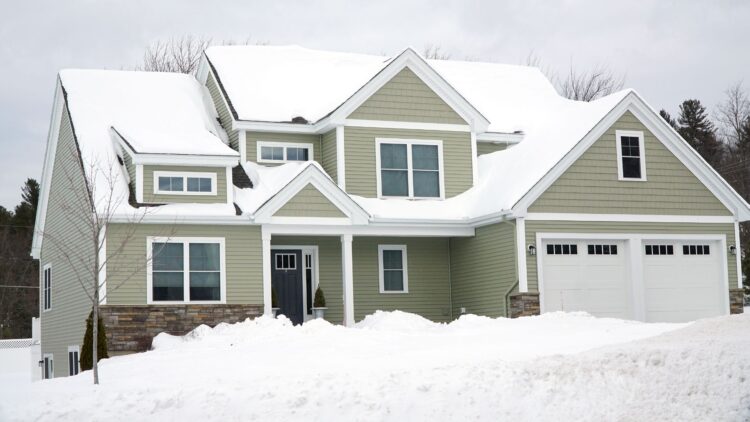
Protecting your roof’s integrity each winter is vital to its long-term health and longevity. While snow is breathtaking when it blankets our area, if heavy snow sits on your roof too long, it can wreak havoc. With lots of snow, any portion of your roof that is vulnerable can become compromised, creating a place moisture can seep into your roof decking and attic.
Learn how to safeguard your home from roof leaks and other costly damage by following these simple winter roof care tips.
4 Tips to Help You Avoid Roof Damage from Winter Weather
1. Remove snow from your roof (down to an inch).
It can be hazardous to remove snow from your roof, so if you are not in great physical condition, hire someone to do this for you. If you decide to remove snow yourself, take proper precautions to avoid injury. It’s hard work, so pace yourself, take breaks, dress in layers, and keep your feet on the ground. Buy a roof rake and add a rubber extension to it in order to protect you. Be cautious if you are working near power lines. Don’t ever get on your roof to rake snow off. That’s too slippery and dangerous! From the ground, slowly pull snow off the roof with your roof rake, being careful to leave one inch of snow on it (to keep from harming roofing components).
2. Prevent damaging ice dams.
When snow melts, runs down your roof, and refreezes near its edges, ice dams and icicles form. This happens when your attic is too warm, causing part of your roof to warm up while its edges remain below freezing. The result? A rim of ice on your roof’s edge that can grow and trap increasingly more water behind it until it forms an ice dam.
The problem with ice dams is that the trapped water works its way back up under your shingles. It can cause roof leaks as water makes its way through your soffits, walls, and ceilings. Ice dams left unnoticed or unaddressed can lead to mold, rot, peeling paint (inside your home), and more.
3. Increase attic ventilation, add insulation, and seal off air leaks.
In most homes, about a third of the heat loss occurs through your ceiling into your attic. Most of the loss comes from air leaks caused by things like unblocked walls, gaps in drywall, old light fixtures, plumbing pipes, chimneys, and other ceiling penetrations.
You’ll be much more likely to avoid ice dams if you increase your attic’s ventilation by adding soffit vents and a ridge vent to circulate cold air under your whole roof. Next, add insulation to your attic. Finally, seal off common air leaks by doing the following:
- Add flashing around your chimneys. Ensure your flashing is intact, and seal it with fire-stop sealant.
- Seal the hatch. An unsealed attic hatch or whole house fan is a huge opening where heat can escape. Cover it with a weather-stripped cap made out of foil-faced foam board that is held together with aluminum tape.
- Install sealed canned lighting. Get rid of old recessed lighting that can’t be insulated without creating a fire hazard. Replace them with IC fixtures (which can be installed in areas where they will be in direct contact with insulation but won’t pose a fire hazard).
4. Keep your gutters clean and free of debris.
Clean your gutters every spring and fall to make sure they are free of leaves, twigs, and other debris. Clean gutters reduce the amount of water that accumulates on them, making it easier to handle and reduce ice dams if they develop.
Safeguard Your Home from Costly Damage with a Stunning New Roof
Don’t settle for worn-out roofing components that put your home at risk of damaging leaks. Get a reliable, beautiful new roof replacement that boosts your home’s value and protection. At Presidential Exteriors, we’re proud members of President’s Club through GAF, the nation’s leading roofing manufacturer. This distinction marks us as the top 1% of all Master Elite Contractors in the U.S. Less than 2% of contractors are Master Elite Certified, making us the very best of the best.
Our team is heavily trained on ventilation requirements as well as insulation best practices for attic spaces. This ensures your roof meets all requirements, and maximizes its lifespan. Learn more about how our roofing services can enhance your home’s curb appeal while protecting it from the elements.